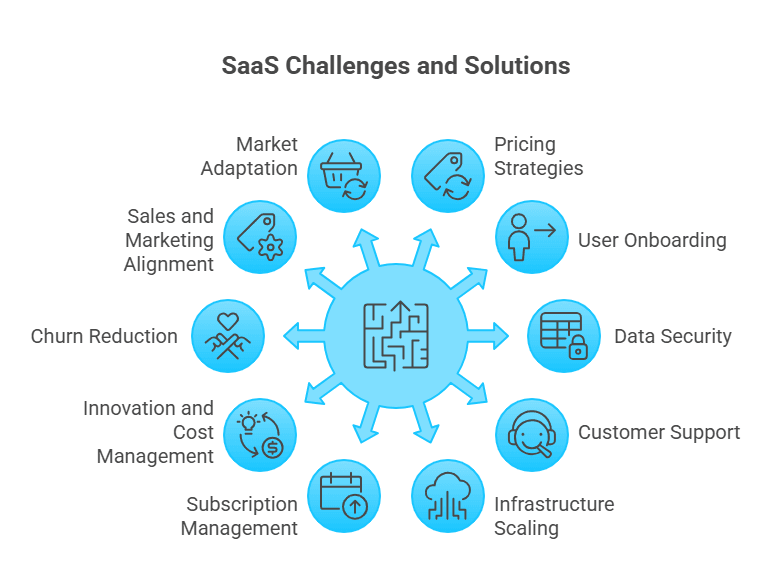Must-Tackle SaaS Challenges Standing Between You and Success

You've built a great SaaS product, but growth isn't what you expected. Churn rates are creeping up, your pricing model feels off, and standing out in an overcrowded market is getting more challenging by the day. Sound familiar?
As companies shift to the cloud, the SaaS market has become increasingly competitive. While rapid adoption offers speed and scalability, it also introduces new challenges, such as securing customer data and risk management for delivering value in business operations and retention. The pressure on SaaS providers is intense, with even industry leaders constantly adapting to remain relevant.
The good news? These challenges aren't unbeatable. In this blog, we'll break down the key hurdles holding SaaS businesses back—and show you how to tackle them before they slow your growth.
What Are the 10 Critical SaaS Challenges to Address for Immediate Success?

SaaS companies face nonstop change, rising costs, and fierce competition. From pricing models to data security and customer retention, the pressure on business processes is increasing, especially compared to traditional software models. Tackle these key challenges to stay ahead, grow stronger, and future-proof your SaaS business.
1. Navigating Complex Pricing Strategies
Pricing your SaaS product can feel like a guessing game. Should you go freemium, tiered, or usage-based? The truth is, there's no one-size-fits-all. What matters is matching your pricing to how your customers think and buy.
Look at Monday.com—they charge per user, scaling with their customers. Smart, right? Flexible pricing isn't just about profits—it's about keeping users happy and sticking around. Get this right, and you've got a serious growth advantage.
2. Enhancing User Onboarding and Education
First impressions matter—and in SaaS, that starts with onboarding for new employees. If new users feel confused or overwhelmed, they will likely walk away, often leading to higher churn rates. That's why a smooth, guided experience is key. Think in-app walkthroughs, video tutorials, and live webinars to make learning easy.
Keep the support going with tooltips, FAQs, and helpful content. The more you invest in user education, the more confident—and loyal—your customers become. Better onboarding = better retention.
3. Ensuring Robust Data Security Measures
When you run a SaaS business, protecting customer data, including health information, isn't optional—it's a must. One slip and you risk losing trust, customers, and much more. That's why encryption, multi-factor authentication, and regular security audits should be standard.
Don't stop there—train your team to spot threats like phishing. With innovative tools and more intelligent people, you'll keep your platform secure, stay compliant, and build absolute trust that keeps users coming back.
4. Improving Customer Support and Satisfaction
Excellent customer service isn't just lovely—it's essential in SaaS. Poor support can quickly break trust and send customers packing. That's why being available with fast, clear help through live chat, email, or FAQs matters so much.
Checking in regularly shows you care, and listening to feedback helps you improve. Customers who feel heard and supported stick around—and even spend more. Solid support builds loyalty and boosts your brand.
5. Scaling Infrastructure Efficiently
As your SaaS business grows, the lack of visibility into your app infrastructure needs to keep up, or risk slowdowns and downtime. Cloud computing makes scaling more manageable, but thoughtful planning is key. Automated scaling and predictive analytics help you handle busy spikes without breaking the bank or the user experience.
Staying agile and efficient means your platform runs smoothly no matter the load, letting you serve more customers without sacrificing quality or control.
6. Managing Subscription Lifecycle and Renewals
Managing the subscription lifecycle is key to keeping your SaaS customers coming back. From onboarding to renewal, staying connected matters. Automated reminders and special offers—like early renewal discounts—make customers feel valued and engaged.
Using subscription management tools helps track essential details so that you can personalize the experience and spot issues early. When you simplify renewals and stay on top of customer needs, everyone wins with a smoother, more loyal relationship.
7. Innovating Continuously While Managing Costs
Innovation is what keeps SaaS products fresh and customers coming back. But spending unthinkingly won't cut it—you've got to balance new features with smart budgeting. Minor updates and better integrations can significantly impact without breaking the bank.
SaaS providers can stay ahead of the competition by focusing on customer needs and carefully managing costs. Steady improvements mean happier users and a healthier bottom line—a win-win for everyone.
8. Reducing Churn and Boosting Customer Loyalty
Let's be honest—churn hurts. You work hard to get a customer, so losing them stings. However, proactive steps can turn things around instead of just ignoring them when they leave. Start by understanding why they churn—price, value, support?
Run exit surveys, check usage data, and spot the warning signs early. Then, offer custom plans, check in more often, or build features users ask for. Reducing churn isn't just damage control—it's how you build long-term loyalty.
9. Aligning Sales and Marketing for Better Growth
Sales and marketing often feel like they're in different worlds, but when they team up, magic happens. Marketing needs to bring in leads through effective social media campaigns that want what you're selling, while keeping an eye on marketing expenses, and sales have to close those leads with the right pitch.
Get both teams on the same page with shared goals, regular sync-ups, and clear handoffs. Use CRM data to understand what messaging works best. When everyone pulls in the same direction, your pipeline flows smoother, and growth follows.
10. Adapting Quickly to Market and Tech Changes
The SaaS world moves fast—new trends, tools, and competitors pop up overnight. If you're not evolving, you're falling behind. That's why staying agile is non-negotiable. Monitor market shifts, customer behavior, and emerging AI or automation technologies.
Adapting doesn't mean overhauling everything—it could be as simple as testing a new feature, reworking your UI, or exploring a fresh integration. The key is staying flexible and open to change so your SaaS offering remains relevant and competitive.
What Are 3 Essential Tools for Analyzing Customer Feedback Effectively?
Customer feedback is not just what people think. It provides key ways to improve SaaS. You can use data analysis tools to make feedback work faster and better.
Tools for Analysis | Key Feature |
|---|---|
You get to make and look at your surveys | |
See where users click and move on your site | |
It sorts feelings and feedback automatically |
When you combine the answers, the SaaS product improves as a whole. If you set up clear campaigns, you turn each opinion into real updates. This helps teams change the way they work as needs arise.
Conquer SaaS Challenges with SmartCue — Your Growth Partner
Struggling with unpredictable customer churn and stagnant growth? SmartCue pinpoints why customers leave, helping you tailor pricing and improve onboarding to boost retention. It also strengthens security and simplifies scaling, all in one platform. With SmartCue’s powerful insights and easy tools, you can keep your SaaS business agile and growing. Ready to overcome your biggest challenges?
Start your 14-day free trial of SmartCue today: Try SmartCue Free
Conclusion
Addressing challenges faced by SaaS companies is vital for long-term success, particularly in customer acquisition. Focus on complex pricing, strong customer support, and robust security to ensure data protection—key elements of your growth strategy. Implementing effective solutions enhances user satisfaction and drives innovation. In the ever-evolving SaaS landscape, staying proactive and adaptable is essential. Tackle these challenges now for your business's success. For tailored assistance, consult our experts today!
Frequently Asked Questions
How do I choose the right pricing model for my SaaS?
When choosing a SaaS pricing model, consider your sales strategies, market demand, and costs. Many opt for freemium or tiered pricing, which allows flexibility for different user groups. Testing and adjusting your models is crucial to aligning with customer needs and supporting your business goals.
What are the best practices for data security in SaaS?
Data security is crucial and requires robust measures to protect sensitive data. Encrypting data and using multi-factor authentication are essential steps. Ensure compliance with regulations like the General Data Protection Regulation (GDPR). Regularly assess security risks to prevent unauthorized access and data breaches. Implementing these practices can enhance your operations, safeguard data, and mitigate potential issues.
How do you overcome customer retention issues in a SaaS model?
To improve customer retention in a SaaS model, enhance user experience, offer excellent support, and engage customers with personalized communication. Gather feedback to refine your service and implement loyalty programs to encourage long-term commitment, fostering stronger client relationships.
How can SaaS companies improve customer retention?
Customer retention goes up when you give people a better user experience, good customer service, and the right SaaS solutions. Building customer trust using loyalty programs and by giving people personal care helps to keep these long-term relationships strong. This way, you can ensure that your business keeps growing.
Comments
Your comment has been submitted successfully!